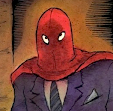 I always ink the artwork I do before applying the watercolor washes. Sometimes I photocopy the line art so I have a record of what it looked like in case I screw up the painting and have to start from scratch. (It's easier to start over by tracing line art than a painting). And sometimes I even save the photocopies of the line art, for some reason. Above is the line art I saved for the front cover of the book PECULIA. At the right is a (slightly dark) scan of the painted art, made after coloring with watercolor washes over the ink lines.
I always ink the artwork I do before applying the watercolor washes. Sometimes I photocopy the line art so I have a record of what it looked like in case I screw up the painting and have to start from scratch. (It's easier to start over by tracing line art than a painting). And sometimes I even save the photocopies of the line art, for some reason. Above is the line art I saved for the front cover of the book PECULIA. At the right is a (slightly dark) scan of the painted art, made after coloring with watercolor washes over the ink lines. The scan was made at the point when  I thought I was done. But after living with it some more (always a good idea), I decided it needed more work.
I thought I was done. But after living with it some more (always a good idea), I decided it needed more work.
 I thought I was done. But after living with it some more (always a good idea), I decided it needed more work.
I thought I was done. But after living with it some more (always a good idea), I decided it needed more work.I lightened her dress (a laborious process that involves blotting the painted area with a wet rag or paper towel to slowly lift off the layers of watercolors, without smudging or smearing any of the areas around it). I had wanted a monochromatic look, but there wasn't enough of a range of values, so lightening the dress, and tweaking the color to be more purple than blue, helped. (I changed the color of the cat as well). Then, for balance, I realized I needed to darken the ground, so I did. I still wasn't 100% satisfied, but I knew I was on the verge of overworking it -- the worst thing you can do with a watercolor painting. If it was oil or acrylic or whatever I'd be able to paint over areas -- and you can even "fake" small areas of watercolors by matching the color in opaque gouache and painting over the watercolor that way. But I'm addicted to the light, transparent look of watercolor and although I have used gouache for corrections occasionally, I really try to avoid it, because the comparative heaviness of the opacity can throw the whole "look" off. So, I reluctantly laid down my brushes. (The age-old question for many a painter is "when is the painting done?" It's easier with watercolor, since you are definitely done when you should have already stopped working on it!).


So I packaged the art along with the title logo I'd drawn and sent it to the publisher, who put together a mock-up of the cover for me to see. That's it at the left. And that's what we went with. (Looking at it now, I think I should have added a bit of shading to her dress. Oh well...) Of course, the final printed version often doesn't look anything like the work at
this stage, so all that's left to do is cross your fingers and hope that they get it as close to the original art as possible. It used to be nearly impossible to get an accurate reproduction of watercolor art in print. I used to have to jack up the color intensity with garish dyes to prevent illustrations in magazines and newspapers from looking completely faded out. And you never knew how it would reproduce until you saw it -- an often disheartening experience! Nowadays, though, thanks to computers, you can get closer than ever to what the original painting looks like. Yay for technology! It's given new life to the old arts. (And to the old artists!).


Hey Richard, great post! I'm always wanting to hear about the artist's process, you should have Robin at the Inkstuds radio program(www.inkstuds.com) interview you, that would be so great. Maybe when Cat Burglar Black comes out.
ReplyDeleteHi, I agree. I find this sort of info fascinating. It's tough being an art lover with no training in making art!
ReplyDelete